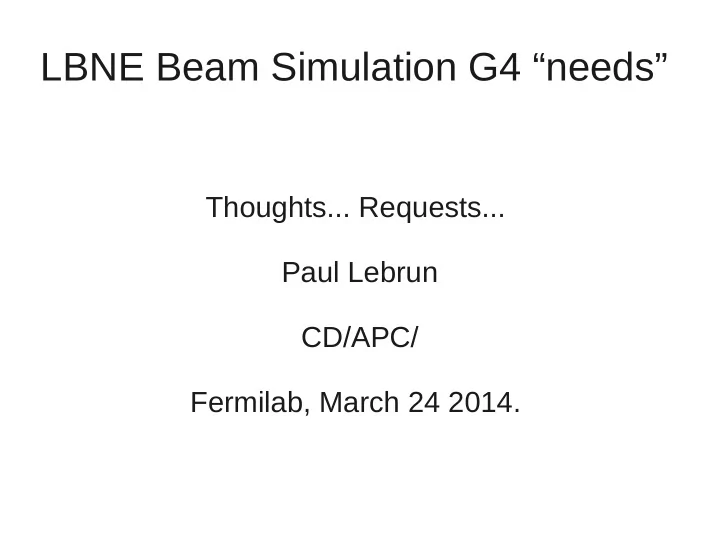

LBNE Beam Simulation G4 “needs” Thoughts... Requests... Paul Lebrun CD/APC/ Fermilab, March 24 2014.
Take Home message ● For the most part, Geant4 and MARS are adequate for we need to do. Assuming that a ~10 to 15 % absolute prediction of the unoscillated neutrino flux intensity at the far detector is O.K. ● But CD/SSA/Scientific Computing Simulation team can help: ● Infrastructure & G4 expertise ● Expertise in Hadronic physics and simulators. ● Direct (“in kind”) contributions to g4lbne program.
Goals for G4LBNE ● Systematic uncertainties in predicting the neutrino flux, for the current and/or likely design.. For Oscillation Physics, not Hadronic physics. ● Near Detector presence is a requirement, at this point... – We hope this is the case. ● Thus interested mostly in the “double ratio” vs energy, i.e., Far D. To near D., realistic implementation vs nominal. Many, many systematic uncertainties cancel out ! (See recent LBNE Doc db, from L. Fields et al) ● As M. Bishai recently stated in a Snowmass P5 discussion, LBNE Oscillation physics will be statistically limited for a long, long time.. Agreed.. (sigh...) ● Support alternative designs: ● 1.2 MW vs 700 MW : New target. ● Increase the flux, within budget. – Examples: Horn1 upstream section modifications ● Reduce backgrounds ... secondary target idea.. (John LoSecco, P. L.,...)
MARS & Geant4 ● Both codes are used, as (it should be), are complementary but have different strengths.. ● G4 : HEP aspects.. ● MARS: Shielding.. ● Interface: ● GDML: MARS -> ROOT geometry -> GDML -> Geant4 – The Hadron absorber absorber has been solely designed in Mars, and taken as such into G4LBNE executable. ● Above is a rough distinction... ● Byron Lundberg is using MARS to optimize the Horn1 configuration with the 1.2 MW target configuration. ●
G4LBNE, Infrastructure needs ● Installation of usual tools ● But which build/install tools to use? ● Who's gona do it? ● Consequently, our team has been perhaps rather slow at Sl5 -> SL6, ROOT version , Geant4 version ● Stable, but improvments are missed. ● Not Comfusing Division problem, more like a LBNE problem ? Or, somewhere in between...
G4LBNE, “Valgrind” commissioning ● Good practice to hunt for memory handling problems, initialization of variables, etc... ● Geant4 experts at CERN use “coverity”, but Fermilab has no license ● CMS uses IgProf, but that's a CMS thing.. ● Advice and support is welcome..
Suggested Improvements to G4 ● Defining the Geometry: ● Tools for Geometry validation How do we certify that we have in Geant4 the geometry we intend to have? ● Towards a “surveyed geometry” – A G4 Surveyor class: ● Distinguishing between “nominal” vs “realistic” ● Prototype implementation in the context of G4LBNE implementation. ● Tools to characterize the Hadronic Model uncertainties.
G4LBNE geometry implementation. ● Input Data: dimensions, positioning, matetrial characteristics, etc.. This gives us the “Nominal” geometry for a given design. ● If expected to be changed by a G4LBNE user, then specific G4 User Interface command implemented ● Else: hard-typed into the constructor of the class that holds the nominal “pre-geometry” ● Possibly pre-checked for overlaps and consistency. ● LBNE Surveyor class gives correction to the above (nominal) positions for the mother volumes that contains critical parts, such as the inner conductors of the horns. ● The G4 is created (G4Volume, G4PVPlacement, etc...) based on the above information. ● Overlaps “spot-checks” .
G4LBNE geometry certification. ● Current method: ● Trying to documenting each constant with sources (blue print, LBNE docs,.. ), in case “after thoughts” ● Check with geantino trajectories, de-facto making specific sets of volume temporary “sensitive”, and dumping 3D track to surface intersection into Ntuples, such that geometrical feature appear on sctter plots. ● Visualization: Does the 3D volumes looks good? Is this wire frame looks correct.
Credit: Seongtae Park, Feb. 2014.
??? Credit: Seongtae Park, Feb. 2014. Mistake was mine: diameter vs radius !! of a fixture holding precision machine aluminum cylinders. How do we catch all such mistakes?.. ==> Validation is a tricky business.
The fully automated CAD -> Geant4 geometry is typically found very awkward, because - Possible incompatibilities in CAD -> GDML translators. - It would produce very heavy geometries, with many undesirable details. - Contains equations that non-standard (parabolic conductor) - no direct support for alignment or survey data.. So, geometry is coded up the old-fashion way.. No automated software tools could catch such a mistake: the faulty geometry was “Geant4 lawful” G4LBNE users (outside fnal.gov) have no easy access to FNAL BD drawings, making it difficult more difficult to verify the coding. User's not acquainted with the real thing. So, life is tedious.
Comments on systematics uncertainties from Hadronic “G4-physics lists” Affects all HEP frontiers: ● Energy (LHC background modeling) ● Cosmic : UHECR and extended air showers. ● Intensity: Modeling of pion production for neutrino beams. ● Such “Low Pt” physics considered neither fundamentals not compelling ● Tedious work in comparing data vs data, data vs various models. ● Note: ● Running a bunch of models and take the variance of what we are after ● (i.e., flux at the far detector) does not gives the true systematic uncertainty, only a lower bound on it!. – As it does not include the systematic uncertainties on the pion production cross-section, Pt and Xf distribution, and so forth..
Recommend
More recommend